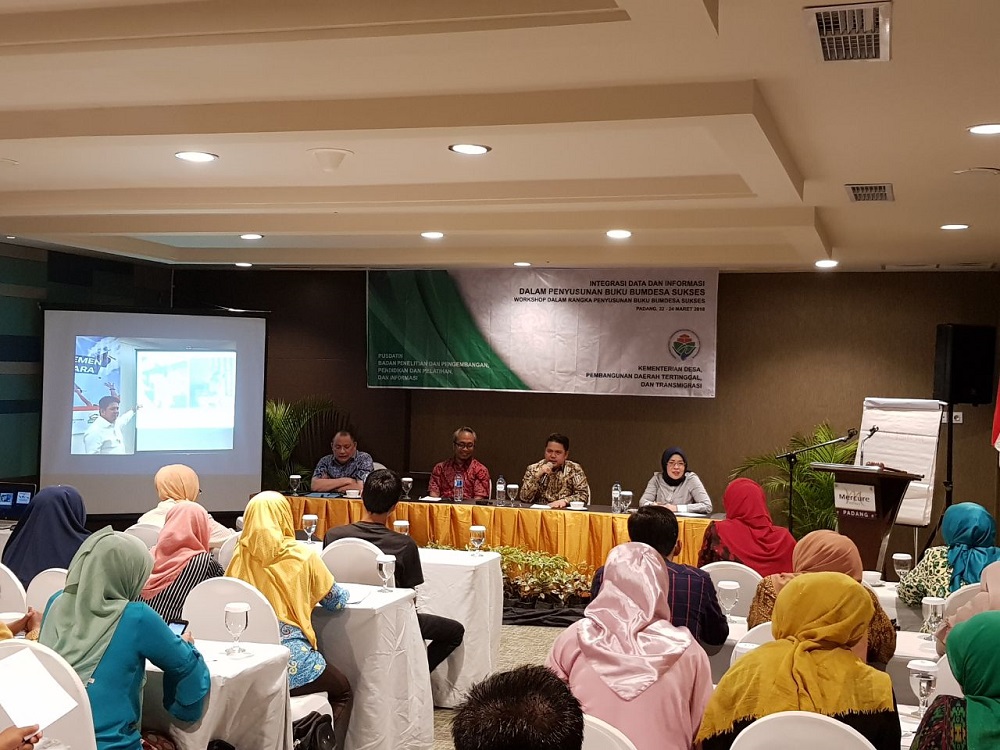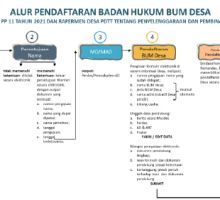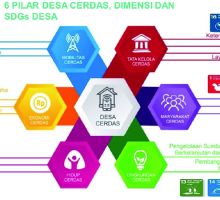By: Herri Santoso, S.Pi
Activator of Non-Governmental Organizations at BBPPMD Jakarta,
BPSDM, Ministry of Villages PDTT
The village or what is called by another name existed before the Unitary State of the Republic of Indonesia was formed. As proof of its existence, the Elucidation of Article 18 of the 1945 Constitution of the Republic of Indonesia (before the amendment) states that "In the territory of the State of Indonesia there are approximately 250 "Zelfbesturende landschappen" and "Volksgemeenschappen", such as villages in Java and Bali, Nagari in Minangkabau , hamlets and clans in Palembang, and so on. These areas have an Original composition and therefore can be considered as special areas. The State of the Republic of Indonesia respects the position of these special regions and all state regulations concerning these areas will remember the rights of origin of the regions. Therefore, its existence must still be recognized and guaranteed its survival in the Unitary State of the Republic of Indonesia.
The diversity of characteristics and types of Villages, or what is called by other names, does not become a barrier for these founding fathers to make their choice in the form of a unitary state. Although it is realized that in a unitary state there needs to be homogeneity, the Unitary State of the Republic of Indonesia still provides recognition and guarantees for the existence of legal community units and customary law community units and their traditional rights.
In the history of Village regulation, several regulations regarding Villages have been stipulated, namely Law Number 22 of 1948 concerning Principles of Regional Government, Law Number 1 of 1957 concerning Principles of Regional Government, Law Number 18 of 1965 concerning Principles of Regional Government. Regional Government, Law Number 19 of 1965 concerning Praja Villages as a Transitional Form to Accelerate the Realization of Level III Regions throughout the Territory of the Republic of Indonesia, Law Number 5 of 1974 concerning the Principles of Government in the Regions, Law Number 5 of 1979 concerning Village Administration, Law Number 22 of 1999 concerning Regional Government, and finally Law Number 32 of 2004 concerning Regional Government.
In its implementation, the regulation regarding the Village has not been able to accommodate all the interests and needs of the Village community, which so far have numbered around 74,000 (seventy four thousand) villages and around 8,000 (eight thousand) sub-districts. In addition, the implementation of village regulations that have been in effect so far are no longer in accordance with the times, especially regarding the position of customary law communities, democratization, diversity, community participation, as well as progress and equitable development, resulting in regional disparities, poverty, and socio-cultural problems. which may disturb the integrity of the Unitary State of the Republic of Indonesia.
With the construction of combining the functions of the self-governing community with local self-government, it is hoped that the customary law community unit, which has been part of the village area, is organized in such a way as to become a village and a traditional village. Traditional Villages and Villages basically perform almost the same tasks. Meanwhile, the difference is only in the implementation of the rights of origin, especially regarding the social preservation of the Traditional Village, the regulation and management of the customary area, the customary peace session, the maintenance of peace and order for the customary law community, as well as the implementation of the governance arrangement based on the original structure.
The birth of Law Number 6 of 2014 concerning Villages considers that the Village has the right of origin and traditional rights in regulating and managing the interests of the local community and plays a role in realizing the ideals of independence based on the 1945 Constitution of the Republic of Indonesia. Another consideration is that in In the course of the state administration of the Republic of Indonesia, Villages have developed in various forms so that they need to be protected and empowered to become strong, advanced, independent and democratic so that they can create a strong foundation in implementing governance and development towards a just, prosperous and prosperous society.
In village development, the village has village authority which includes authority in the field of village administration, implementation of village development, village community development, and village community empowerment based on community initiatives, origin rights, and village customs.
Village authorities include:
a) Authority based on the right of origin;
b) Village-scale local authority;
c) Authority assigned by the Government, Provincial Government, or Regency/Municipal Government; and
d) Other authorities assigned by the Government, Provincial Government, or Regency/Municipal Government in accordance with the provisions of laws and regulations.
The enactment of Law Number 6 of 2014 concerning Villages, as well as Regulations
create added value on Village Assets; and
developing a digital economy ecosystem in the Village.
The issues regulated in Government Regulation Number 11 of 2021 concerning Village-Owned Enterprises are as follows:
1. Access to Capital/Loans.
Prior to Government Regulation Number 11 of 2021 concerning Village-Owned Enterprises, Village-Owned Enterprises (BUMN) were difficult to apply for loans because their status was not yet a legal entity and with performance provisions and clarity of assets to be guaranteed.
2. BUM Desa Tax/Retribution.
Prior to Government Regulation Number 11 of 2021 concerning Village-Owned Enterprises, there has been no effort and understanding regarding retribution and tax incentives for BUM Desa.
3. Termination of Village BUM Business Activities.
As a legal entity, BUM Desa cannot be dissolved, but its business activities can only be stopped.
4. Business Valuation Rules.
Advisors, operational implementers and supervisors are implementers of Village Deliberation decisions.
5. Assistance to BUM Desa.
The implication of having a legal entity is that BUM Desa can be assisted directly or through the Village Budget, as was the case before this arrangement.
6. Transformation and Integration.
The management of the ex-PNPM-MPD Community Revolving Fund must be transformed into BUM Desa together with the aim of providing legal certainty and protection of community assets.
The strengthening of BUM Desa in Government Regulation Number 11 of 2021 concerning Village-Owned Enterprises is as follows:
1. Business Activities and Village BUM Business Units.
As a Legal Entity, BUM Desa can directly run its business (Operating Company) or become the parent of a legal entity business unit (Investment Company).
2. BUM Desa organization.
The BUM Desa organization is separate from the Village Government, consisting of: (1) Village Deliberations; (2) Advisor; (3) Operational Executor; and (4) Supervisor. The authority and duties of each organ have been determined in more detail.
3. BUM Desa Capital and Assets.
Related to the clarity of Village capital participation in the form of goods other than land and buildings which are transferred into BUM Desa assets. BUM Desa can still take economic benefits from land and buildings through a business cooperation scheme.
4. Data collection, guidance and development, and ranking of BUM Desa. ensure that the treatment is in accordance with the needs of BUM Desa that have existed so far, but have not been properly facilitated.
5. BUM Desa is a legal entity.
With a legal entity, BUM Desa has strong bargaining power when dealing with third parties to carry out cooperation and economic activities with banks.
One of the strengthening of BUM Desa as a legal entity needs to be done by submitting the name and registration of the legal entity. The following is the procedure for submitting the name of BUM Desa to the Ministry of Villages, Development of Disadvantaged Regions and Transmigration:
The application for registration of the name of the BUM Desa/BUM Desa together is carried out by the applicant through the Village Information System.
The applicant as referred to in paragraph (1) consists of: a. Village head for BUM Desa; or b. Village head who is authorized by the Village Heads from the founding Village for BUM Desa together
The registration of the name of the BUM Desa/BUM Desa together is carried out prior to the implementation of the Village Deliberation/Inter-Village Deliberation regarding the establishment of BUM Desa/BUM Desa together.
The requirements for submitting the name of BUM Desa/BUM Desa together must meet the following conditions:
does not match or does not resemble the name: (1) BUM Desa/BUM Desa together with others, (2) government institutions; and (3) international institutions;
starting with the phrase BUM Desa and ending with the administrative name of the Village for BUM Desa;
starting with the phrase BUM Desa together for BUM Desa together;
does not conflict with public order and/or decency;
in accordance with or reflecting the aims and objectives, as well as the joint efforts of BUM Desa/BUM Desa;
consists of a series of letters that form a word; and
does not contain foreign languages.
After submitting the name of the BUM Desa to the Ministry of Villages, Development of Disadvantaged Regions and Transmigration, an electronic name approval will be issued containing:
Name registration number;
Usable name;
Applicant's name;
Name registration date;
Expiration date (40 working days)
BUM Desa after obtaining approval then prepares the following documents:
Minutes of the Village Deliberation
Village Head Regulations
Articles of Association of BUM Desa
Bylaws of BUM Desa
Work program
The five documents were then uploaded to the Ministry of Villages, Development of Disadvantaged Regions and Transmigration. The verification team will verify the documents. Then after passing the verification, the Village Ministry will forward it to the Ministry of Law and Human Rights. Based on data from the Ministry of Villages, Development of Disadvantaged Regions and Transmigration, the Ministry of Law and Human Rights issues an electronic registration certificate for Village BUM Legal Entities.
The following is the flow for submitting the name of the Village BUM and the Registration of the Village BUM Legal Entity.



